Speed reading techniques and exercises
How to speed read and how to improve reading comprehension?
 You certainly heard of speed reading: But what’s the big deal about it? Well, there’s lots of money made with speed reading courses and trainings in the first place. Nevertheless, when you manage to adopt any kind of speed reading techniques you can save time, energy and brain cells.
You certainly heard of speed reading: But what’s the big deal about it? Well, there’s lots of money made with speed reading courses and trainings in the first place. Nevertheless, when you manage to adopt any kind of speed reading techniques you can save time, energy and brain cells.
Learning speed reading is hard work. However, there are some tips and methods for instant help. Given the right techniques you can learn speed reading quick and easy – without the need of taking expensive speed reading classes. Here are the 11 best techniques to improve reading skills.
Speed reading techniques & reading comprehension strategies
1. Adjust Reading Speed to the Text Type and Intention
The most important rule: merely scan easy texts, newspaper articles and less important stuff. But also the „tough nuts“ should be just browsed at the first time you read them. Not till then you should take your dissection tools (pen, ruler, marker) and analyze deeper in the second and third turn.
2. Law of Forced Efficiency
Who forces himself to read faster and keeps the time in mind, will de facto read faster! Hence set deadlines for speed reading, e.g.
- 1 hour for a journal article
- 45 minutes for 20 pages in the reference book.
That will force you to select and will decrease deviations.
3. Avoid Regressions & Rebounds
Rebounds of the eyes and quiet whispering while reading are the enemies of speed reading. Imagine the text is an action movie and there’s a car chase happening between the lines. Like in the cinema you can’t „rewind“ the movie – it’s absolutely not helpful to step back everytime you didn’t get the meaning of a sentence immediately. Usually it will become clear later through the context.
4. Use the Floodlight Technique Instead of a Flashlight
As well as stepping back will slowdown you, so do the so called eye „fixations“. It’s comparable to a small flashlight with which you’re looking for something in the grass – at night. It’s way better to divide the sentence into meaningful word groups.
Example: Try to capture | a text span | of 3-4 words. | Browse over the | lines like a | floodlight of a car.
Apply this speed reading exercise the next time you read something. It’s unfamiliar first, but soon you’ll notice improvements.

Speed reading: You can learn it with the right technique with reading strategies
5. Enrich your Vocabulary
The more diverse your vocabulary is, the better your text comprehension will be. This especially applies for reference texts and foreign languages.
Instead of slowing down your reading experience by looking for words in the dictionary, better have a paper beneath your book. There you can note all the unclear terms and in the evening you can look for the „new vocabulary“. Then they can perfectly commit to your memory overnight.
6. Visualize It – Roll It!
So we’re back at the cinema metaphor. Let a mental movie play in your head: the words will become more plastic, theories come alive and you become a part of the story!
By associating new topics with images your reading comprehension and memory will increase tremendously. On very „brutal“ pages you only have one chance left: get out your pen and visualize connections with a self-provided schema.
7. Text Rebels
There is an assumption that lurks in our heads since our school days:
„Texts are linear, i.e. you start from the front and read line by line until the end.“
Forget that! It appears to me as if you would take a tourist through ANY area street by street to show him all the sights and attractions of a city! As a good tourist guide you sure would concentrate on the most important sites and highlights. For reading strategies that means: get a good overview of the text and then read selectively. (Warning: This fits for reference texts and inquiries, not implicitly for educational books which stick to certain didactics.)
8. Structural Reading
Every text has a certain architecture. Any structural element has a certain function – like a bathroom, kitchen and bedroom have a function, too. There are passages for justifications from adverse scientific colleagues; long methodical descriptions keep up the traceability; implications for further research are totally dull for a basic course. All these elements are only ballast for you which you can easily fly over. Hold on to the more „comfortable rooms“.
9. Improved Reading Goes Step by Step – Don’t Get Impatient!
Investments in the beginning will pay off later. You need connections in the brain until you can really understand an unknown text – which aren’t available at the first reading.
Be patient! It’s perfectly normal when you don’t understand the whole text after the first reading. Browse over the lines to get a feeling for important terms, concepts and the context. On the second reading you will have much more background information – the text’s context will unlock easier now. By the third time (e.g. on the repetition) you can reach comprehension of 70-90%. That will be enough for any purpose – you won’t need any small details anyway!
10. Discuss with the Text
When reading you always have to compromise between comprehension and speed. Not before you’re skilled enough and know some more techniques can you increase both. One technique, which slows down the speed but also increases reading comprehension and memory, is called „discussing with the text„.
By continuously asking questions to the text and adding notes like „don’t get that“, „an example would be great“ or „aha! Here the author recurs on the first part“ you can process more intensively and simultaneously express your emotions while reading.
11. Time Management when Reading
Yes, it’s possible to read too slowly! Whoever reads too slowly usually reads too unconcentrated, thoughts wander around. Hence full power and total focus on the text through self-imposed deadlines (30 pages per hour, see 2.) are powerful.
One trick for that: Sit at your desk and read 45 minutes concentrated, then lean back or lie down for 15 minutes to process the new data, then start with the next 30 pages. Alternatively you can have a power nap in the break time (remember to set the alarm!). Why does that work? If you’re too tired, the brain falls back into slow reading and wants to read word for word. When you’re energetic you can more than overcompensate for the breaks!
Learn How to Speed Read: Tips in Short
- Speed reading: Adjust the technique to the text
- Speed reading: Limit the time – so you will get more efficient
- Speed reading: Don’t rebound
- Speed reading: Increase your view span and capture 2-3 words at once
- Speed reading: Enrich your vocabulary
- Speed reading: Roll it! „Watch“ a mental cinema movie while reading
- Speed reading: Read „hierarchic“ instead of linear
- Speed reading: Read the text repeatedly & fast – not 1x too precisely
- Speed reading: Be patient tho‘ you don’t comprehend at 1st try
- Speed reading: Improve reading comprehension through „discussing“
- Speed reading: Combine time management and speed reading techniques
Good luck trying out my speed reading techniques!
What are your experiences with speed reading? Can you speed read and comprehend more through speed reading techniques in studies and your job?